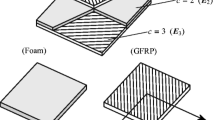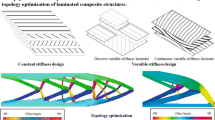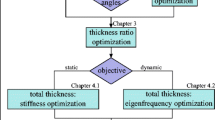Abstract
In this study, two optimality criteria are presented for optimum design of composite laminates using finite element method. Thickness of the layers and fiber orientation angles in each finite element are considered as the design variables. It will be shown that the optimum design of composite laminates with varying fiber orientations and layers thicknesses may be found by using these optimality criteria in an efficient way, without performing the sensitivity analysis.
Similar content being viewed by others
References
Adali S (1983) Design sensitivity analysis of an antisymmetric angle ply laminate. Eng Optim 7:69–83
Adelman HM, Haftka RT (1986) Sensitivity analysis for dicrete structural systems. AIAA J 24:823–832.
António CAC, Marques AT, Soeiro AV (1995) Optimization of laminated composite structures using a bilevel strategy. Compos Struct 33:193–200
Arora JS (1989) Introduction to optimum design. McGraw-Hill, New York
Berthelot JM (1999) Composite materials: mechanical behaviour and structural analysis. Springer, Berlin Heidelberg New York
Burns T, Cherkaev A (1997) Optimal distribution of multimaterial composites for torsional beams. Struct Optim 13(1):4–11
Díaz AR, Sigmund O (1995) Checkerboard patterns in layout optimization. Struct Optim 10:40–45
Fang C, Springer GS (1993) Design of composite laminates by a Monte Carlo method. J Compos Mater 27(7):721–753
Felippa CA (2003) A study of optimal membrane triangles with drilling freedoms. Comput Methods Appl Mech Eng 192(16):2125–2168
Fukunaga H, Vanderplaats GN (1990) Optimum design of laminated composite structures. In: de Wilde WP, Blain WR (eds) Composite materials design and analysis. Springer, Berlin Heidelberg New York, pp 493–497
Fukunaga H, Vanderplaats GN (1991) Strength optimization of laminated composites with respect to layer thickness and/or layer orientation angle. Comput Struct 40(6):1429–1439
Fukunaga H, Sekine H (1993) Optimum design of composite structures for shape, layer angle and layer thickness distributions. J Compos Mater 27(15):1479–1492
Gáspár ZS, Lógó J, Rozvany GIN (2002) On design-dependent constraints and singular topologies. Struct Multidisc Optim 24(4):338–342
Grandhi RV (1993) Structural optimization with frequency constraints—a review. AIAA J 32:2296–2303
Gürdal Z, Olmedo R (1993) In-plane response of laminates with spatially varying fiber orientations: variable stiffness concept. AIAA J 31(4):751–758
Haftka RT, Adelman HT (1989) Recent developments in structural sensitivity analysis. Struct Optim 1:137–151
Haftka R, Prasad B (1981) Optimum structural design with plate bending elements—a survey. AIAA J 19:517–522
Hyer MW, Charette RF (1991) Use of curvilinear fiber format in composite structure design. AIAA J 29:1011–1015
Hyer MW, Lee HH (1991) The use of curvilinear fibre format to improve buckling resistance of composite plates with central circular holes. J Compos Struct 18:236–261
Jog CS, Haber RB (1996) Stability of finite elements models for distributed-parameter optimization and topology design. Comput Methods Appl Mech Eng 130:203–226
Kalamkarov AL (1997) Optimal design of fiber-reinforced laminates. ASTM Spec Tech Publ 1309:237–249
Kam TY, Lai MD (1989) Multilevel optimal design of laminated composite plate structures. Comput Struct 31:197–202
Kam TY, Snyman JA (1991) Optimal design of laminated composite plates using a global optimization technique. Compos Struct 19:351–370
Kasap I, Oral S (1997) The effect of curved fiber courses in the design of composite laminates. In: Gutkowski W, Mroz Z (eds) Proceedings of the second world congress of structural and multidisciplinary optimization, Zakopane, Poland pp 675–679, 26–30 May 1997
Katili I (1993) A new discrete Kirchhoff–Mindlin element based on Mindlin–Reinssner plate theory and assumed shear strain fields—part I: an extended DKT element for thick-plate bending analysis. Int J Numer Methods Eng 36:1859–1883
Kengtung C (1986) Sensitivity analysis and a mixed approach to the optimization of symmetric layered composite plates. Eng Optim 9:233–248
Khosravi P, Sedaghati R, Ganesan R (2007a) Optimization of geometrically nonlinear thin shells subject to displacement and stability constraints. AIAA J 45(3):684–692
Khosravi P, Sedaghati R, Ganesan R (2007b) Optimization of stiffened panels considering geometric nonlinearity. J Mech Mater Struct 2(7):1247–1263
Khosravi P, Ganesan R, Sedaghati R (2007c) An efficient facet shell element for corotational nonlinear analysis of thin and moderately thick laminated composite structures. Comput Struct (in press)
Kodiyaiam S, Nagendra S, DeStefano J (1996) Composite sandwich structure optimization with application to satellite components. AIAA J 34(3):614–621
Landriani GS, Rovati M (1991) An optimal design for two-dimensional structures made of composite materials. J Eng Mater Technol 113:341–354
Le Riche R, Haftka RT (1995) Improved genetic algorithm for minimum thickness composite laminate design. Compos Eng 5(2):143–161
Lin CC, Yu AJ (1991) Optimum weight design of composite laminated plates. Comput Struct 38(5/6):581–587
Lógó J (2005) New types of optimal topologies by iterative method. Mech Struct Mach 33:149–171
Miravete A (1990) Analysis and optimization of simple composite structures. In: de Wilde WP, Blain WR (eds) Composite materials design and analysis. Springer, Berlin Heidelberg New York, pp 529–547
Morton SK, Webber JPH (1997) Heuristic design of composite laminates for strength stiffness and multiple load cases. Aeronaut J 101(1001):35–45
Mota Soares CM, Correia VF, Mateus H, Herskovits J (1995) A discrete model for the optimal design of thin composite plate-shell type structures using a two-level approach. Compos Struct 30:147–157
Muc A (1988) Optimal fiber orientation for simply-supported angle-ply plates under biaxial compression. Compos Struct 9:161–172
Olmedo R, Gürdal Z (1993) Buckling response of laminates with spatially varying fiber orientations. In: Proceedings of the AIAA/ ASME/ASCE/AHS/ASC 34th SDM Conference, La Jolla, CA, pp 2261–2269, 19–21 April 1993
Parnas L, Oral S, Ceyhan Ü (2003) Optimum design of composite structures with curved fiber courses. Compos Sci Technol 63:1071–1082
Pedersen P (1987) On sensitivity analysis and optima1 design of specially orthotropic laminates. Eng Optim 11:305– 316
Poulsen TA (2002) A simple scheme to prevent checkerboard patterns and one node connected hinges in topology optimization. Struct Multidisc Optim 24:396–399
Rao KP, Issac JC, Viswanath S, Murthy SS (1991) Optimum design of composite laminates for strength by ranking. J Reinf Plast Compos 10:477–494
Reiss R, Ramachandran S (1987) Maximum frequency design of symmetric angle-ply laminates. Composite structures 4(1). In: Marshall IH (ed) Analysis and design studies. Elsevier, London, pp 1476–1487
Sadr H, Afzali M, Sabzevari H (1989) Calcul et optimisation des structures composites stratifiees. Rapport CETIM Senlis
Schmit LA, Mehrinfar (1982) Multilevel optimum design of structures with fiber-composite stiffened panel components. AIAA J 20:138–147
Sigmund O, Petersson J (1998) Numerical instabilities in topology optimization—a survey on procedures dealing with checkerboards, mesh—dependencies and local minima. Struct Optim 16:68–75
Tsai SW, Hahn HT (1980) Introduction to composite materials. Technomic, Lancaster, PA
Valido AJ, Cardoso JB (2003a) Geometrically nonlinear composite beam structures: optimal design. Eng Optim 35(5): 553–560
Valido AJ, Cardoso JB (2003b) Geometrically nonlinear composite beam structures: design sensitivity analysis. Eng Optim 35(5):531–551
Verijenko VE, Johnson JD (1996) Design synthesis of composite structures through the integration of optimization techniques and finite element analysis. Computer aided design in composite material technology—international conference. Computational Mechanics, Southampton, pp 197–206
Watkins RI (1987) Multilevel optimization of composite structures. In: Proceedings of the fourth international conference on composite structures. Elsevier Applied Science, Paisley, Scotland pp 1393–1403
Watkins RI, Morris A (1987) A multicriteria objective function optimization scheme for laminated composites for use in multilevel structural optimization schemes. Comput Methods Appl Mech Eng 60:233–251
Weiji L, Boohua S (1986) Multilevel optimization procedure of composite structures. Comput Struct 26:1357–1367
Zynczowski M (1992) Recent advances in optimal structural design of shells. Eur J Mech A Solids 11:5–24
Zhou M, Shyy YK, Thomas HL (2001) Checkerboard and minimum member size control in topology optimization. Struct Multidisc Optim 21:152–158
Author information
Authors and Affiliations
Corresponding author
Rights and permissions
About this article
Cite this article
Khosravi, P., Sedaghati, R. Design of laminated composite structures for optimum fiber direction and layer thickness, using optimality criteria. Struct Multidisc Optim 36, 159–167 (2008). https://doi.org/10.1007/s00158-007-0207-2
Received:
Revised:
Accepted:
Published:
Issue Date:
DOI: https://doi.org/10.1007/s00158-007-0207-2




